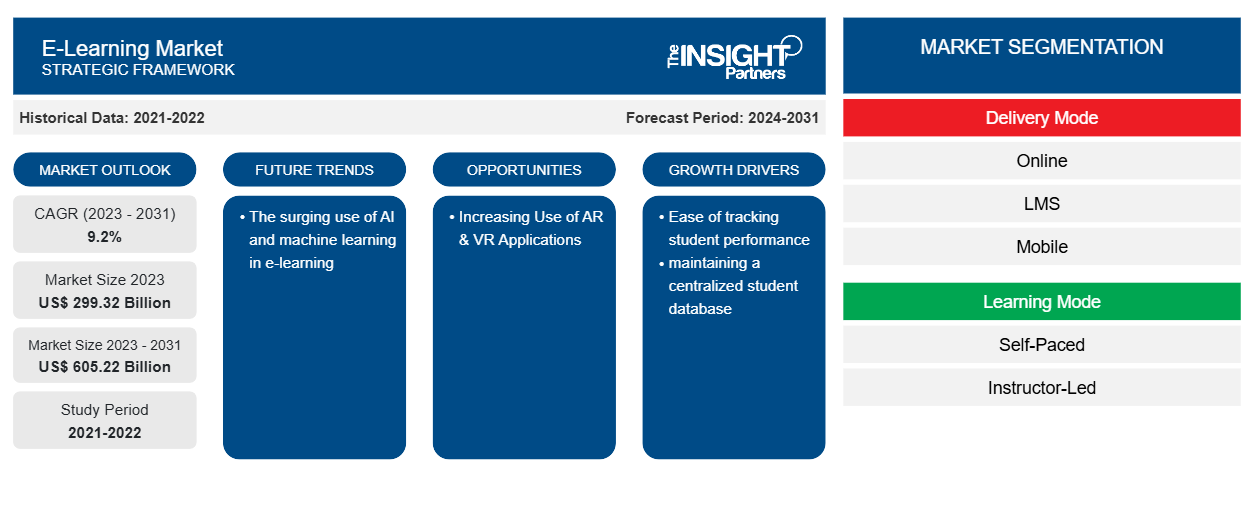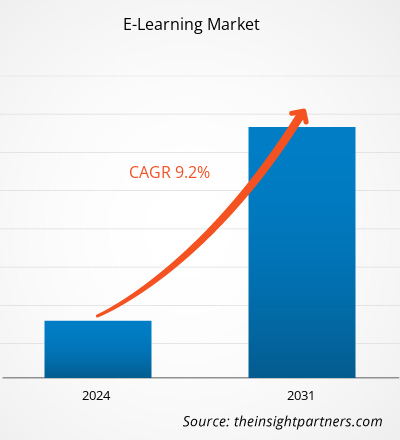E-Learning Market Dynamics and Developments by 2031
Historic Data: 2021-2022 | Base Year: 2023 | Forecast Period: 2024-2031E-Learning Market Size and Forecast (2021 - 2031), Global and Regional Share, Trend, and Growth Opportunity Analysis Report Coverage: By Delivery Mode (Online, LMS, Mobile, and Others), Learning Mode (Self-Paced and Instructor-Led), and End User [Academic (K-12 and Higher Institution) and Corporate], and Geography
- Report Date : Feb 2026
- Report Code : TIPRE00003397
- Category : Technology, Media and Telecommunications
- Status : Data Released
- Available Report Formats :


- No. of Pages : 150
The E-Learning market size is projected to reach US$ 605.22 billion by 2031 from US$ 299.32 billion in 2023. The market is expected to register a CAGR of 9.2% during 2023–2031. The surging use of AI and machine learning in e-learning is likely to remain a key trend in the market.
E-Learning Market Analysis
Online and technology-driven education has surpassed classroom-based education in terms of cost, accessibility, time, and convenience. Students can enhance their skills by enrolling in courses provided by top experts and universities worldwide. Aside from students, working professionals are another important target segment for digital learning organizations. Online certifications have become increasingly popular in today's competitive corporate climate. Continuous skill upgrading is expected in various industries, including IT, BPOs, KPOs, and start-ups. Corporate personnel are increasingly taking online courses to remain ahead of the curve, while most professionals demand certificates for their jobs.
E-Learning Market Overview
The digital learning market is rapidly expanding in developing countries, with a high number of start-ups joining the sector. The digital learning sector is driven by factors such as increased internet usage, time constraints, geographical obstacles, and reduced costs for online training. These drivers promote self-paced learning and expand its scope. As the demand for quality certification grows, more people are turning to online learning programs.
Customize This Report To Suit Your Requirement
You will get customization on any report - free of charge - including parts of this report, or country-level analysis, Excel Data pack, as well as avail great offers and discounts for start-ups & universities
E-Learning Market: Strategic Insights

-
Get Top Key Market Trends of this report.This FREE sample will include data analysis, ranging from market trends to estimates and forecasts.
E-Learning Market Drivers and Opportunities
Rising Number of Connected Devices and Growing Internet Penetration to Favor the Market
The demand for connected devices, such as tablets, laptops, and smartphones, is increasing globally. The demand is further catalyzed due to learn-from-home and work-from-home scenarios. As students could not attend school or tuition classes due to the lockdown and social distancing measures due to the COVID-19 pandemic, their education was conducted online, eventually propelling the demand for smartphones and laptops. Moreover, the development of telecommunication services globally has led to a rise in internet penetration, even in the remote areas of the world, this is supplementing the global e-learning market.
Increasing Use of AR & VR Applications
In recent years, Augmented Reality (AR) and Virtual Reality (VR) technologies have gained appeal in the education and training industries as excellent methods for improving the learning experience. AR and VR can provide remote and flexible learning, allowing students to access training materials and simulations from anywhere in the world. This can be especially useful when students are unable to attend in-person training sessions.
E-Learning Market Report Segmentation Analysis
Key segments that contributed to the derivation of the E-Learning market analysis are delivery mode, learning mode, and end user.
- Based on delivery mode, the E-Learning market is divided into online, LMS, mobile, and others. The online segment held a larger market share in 2023.
- By learning mode, the market is segmented into self-paced and instructor-led.
- By end user, the market is segmented into academic and corporate. K-12 and higher institutions are the prominent sub-segments of the end user segment.
E-Learning Market Share Analysis by Geography
The geographic scope of the E-Learning market report is mainly divided into five regions: North America, Asia Pacific, Europe, Middle East & Africa, and South & Central America.
North America dominated the E-Learning market share in 2023. As per the HurixDigital 2023 report, the US is one of the world's leading countries in terms of successful eLearning implementation in education.
E-Learning Market Regional Insights
The regional trends and factors influencing the E-Learning Market throughout the forecast period have been thoroughly explained by the analysts at The Insight Partners. This section also discusses E-Learning Market segments and geography across North America, Europe, Asia Pacific, Middle East and Africa, and South and Central America.
E-Learning Market Report Scope
| Report Attribute | Details |
|---|---|
| Market size in 2023 | US$ 299.32 Billion |
| Market Size by 2031 | US$ 605.22 Billion |
| Global CAGR (2023 - 2031) | 9.2% |
| Historical Data | 2021-2022 |
| Forecast period | 2024-2031 |
| Segments Covered |
By Delivery Mode
|
| Regions and Countries Covered |
North America
|
| Market leaders and key company profiles |
|
E-Learning Market Players Density: Understanding Its Impact on Business Dynamics
The E-Learning Market is growing rapidly, driven by increasing end-user demand due to factors such as evolving consumer preferences, technological advancements, and greater awareness of the product's benefits. As demand rises, businesses are expanding their offerings, innovating to meet consumer needs, and capitalizing on emerging trends, which further fuels market growth.

- Get the E-Learning Market top key players overview
E-Learning Market News and Recent Developments
The E-Learning market is evaluated by gathering qualitative and quantitative data post primary and secondary research, which includes important corporate publications, association data, and databases. A few of the developments in the E-Learning market are listed below:
- William Woods University WWU) today officially announced an agreement with Coursera, a global online learning platform, that will significantly expand access to digital content that is relevant to today’s workplace, offering skills training and industry-recognized certifications of in-demand job skills to WWU students, staff, alumni and university partners. The new partnership will allow William Woods to learn from over 325 top universities and companies on Coursera, with online courses and credentials in a variety of disciplines and thread it into the university’s curriculum, further enhancing the academic experience and employment marketability of every WWU student. (Source: William Woods University, Press Release, February 2024)
- edX and Degreed announced an expanded strategic partnership to provide organizations with premier educational content and platform solutions that drive skills-based learning. Now, edX For Business – a best-in-class content solution for organizations looking to drive more impactful learning and development programs – is available to organizations and their employees directly within the Degreed platform, reflecting a concerted effort to redefine how companies train, upskill, and retain talent across every level of their workforce. (Source: edX, Press Release, December 2023)
E-Learning Market Report Coverage and Deliverables
The “E-Learning Market Size and Forecast (2021–2031)” report provides a detailed analysis of the market covering below areas:
- E-Learning market size and forecast at global, regional, and country levels for all the key market segments covered under the scope
- E-learning market trends as well as market dynamics such as drivers, restraints, and key opportunities
- Detailed PEST/Porter’s Five Forces and SWOT analysis
- E-learning market analysis covering key market trends, global and regional framework, major players, regulations, and recent market developments
- Industry landscape and competition analysis covering market concentration, heat map analysis, prominent players, and recent developments for the E-Learning market
- Detailed company profiles
Frequently Asked Questions
Which region dominated the E-Learning market in 2023?
What are the driving factors impacting the E-Learning market?
What are the future trends of the E-Learning market?
Which are the leading players operating in the E-Learning market?
What would be the estimated value of the E-Learning market by 2031?
What is the expected CAGR of the E-Learning market?
Ankita is a dynamic market research and consulting professional with over 8 years of experience across the technology, media, ICT, and electronics & semiconductor sectors. She has successfully led and delivered 100+ consulting and research assignments for global clients such as Microsoft, Oracle, NEC Corporation, SAP, KPMG, and Expeditors International. Her core competencies include market assessment, data analysis, forecasting, strategy formulation, competitive intelligence, and report writing.
Ankita is adept at handling complete project cycles—from pre-sales proposal design and client discussions to post-sales delivery of actionable insights. She is skilled in managing cross-functional teams, structuring complex research modules, and aligning solutions with client-specific business goals. Her excellent communication, leadership, and presentation abilities have enabled her to consistently deliver value-driven outcomes in fast-paced and evolving market environments.
- Historical Analysis (2 Years), Base Year, Forecast (7 Years) with CAGR
- PEST and SWOT Analysis
- Market Size Value / Volume - Global, Regional, Country
- Industry and Competitive Landscape
- Excel Dataset
Recent Reports
Testimonials
The Insight Partners' SCADA System Market report is comprehensive, with valuable insights on current trends and future forecasts. The team was highly professional, responsive, and supportive throughout. We are very satisfied and highly recommend their services.
RAN KEDEM Partner, Reali Technologies LTDsI requested a report on a very specific software market and the team produced the report in a few days. The information was very relevant and well presented. I then requested some changes and additions to the report. The team was again very responsive and I got the final report in less than a week.
JEAN-HERVE JENN Chairman, Future AnalyticaWe worked with The Insight Partners for an important market study and forecast. They gave us clear insights into opportunities and risks, which helped shape our plans. Their research was easy to use and based on solid data. It helped us make smart, confident decisions. We highly recommend them.
PIYUSH NAGPAL Sr. Vice President, High Beam GlobalThe Insight Partners delivered insightful, well-structured market research with strong domain expertise. Their team was professional and responsive throughout. The user-friendly website made accessing industry reports seamless. We highly recommend them for reliable, high-quality research services
YUKIHIKO ADACHI CEO, Deep Blue, LLC.This is the first time I have purchased a market report from The Insight Partners.While I was unsure at first, I visited their web site and felt more comfortable to take the risk and purchase a market report.I am completely satisfied with the quality of the report and customer service. I had several questions and comments with the initial report, but after a couple of dialogs over email with their analyst I believe I have a report that I can use as input to our strategic planning process.Thank you so much for taking the extra time and making this a positive experience.I will definitely recommend your service to others and you will be my first call when we need further market data.
JOHN SUZUKI President and Chief Executive Officer, Board Director, BK TechnologiesI wish to appreciate your support and the professionalism you displayed in the course of attending to my request for information regarding to infectious disease IVD market in Nigeria. I appreciate your patience, your guidance, and the fact that you were willing to offer a discount, which eventually made it possible for us to close a deal. I look forward to engaging The Insight Partners in the future, all thanks to the impression you have created in me as a result of this first encounter.
DR CHIJIOKE ONYIA MANAGING DIRECTOR, PineCrest Healthcare Ltd.Reason to Buy
- Informed Decision-Making
- Understanding Market Dynamics
- Competitive Analysis
- Identifying Emerging Markets
- Customer Insights
- Market Forecasts
- Risk Mitigation
- Boosting Operational Efficiency
- Strategic Planning
- Investment Justification
- Tracking Industry Innovations
- Aligning with Regulatory Trends




















 Get Free Sample For
Get Free Sample For